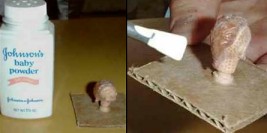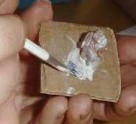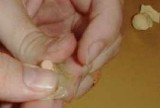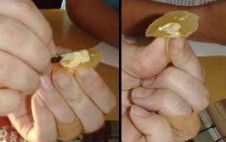Head
Removal from the Action Figure Body
This
procedure has been documented in the Boil &
Pop sectionÖ Just be sure that the recently removed head has cooled
to room temperature before proceeding.
Securing
the Head
Place
a small dab of white glue in the center of the 2Ē X 2Ē piece of cardboard.
Glue the head ďstemĒ to the cardboard in an upright position. The
cardboard will allow you to keep the head secure and hands free while applying
the latex. It will also provide a base for the flange of latex that
will be needed during the mold making process. The use of white glue
is because it isnít very permanent and can be easily removed later.
Initial
Layers of Latex Rubber
 Once the white glue has completely dried, youíre ready to start adding
the latex rubber and start making your mold. Youíll lay down several
coats of rubber throughout the entire process, but these first couple of
coats are very important to get right. Pour a light dusting of talcum powder
over the head and the cardboard. Blow off any excess as all you want
is a very thin layer. This will help in getting the latex mold off
the head when youíre done. The picture to the left shows the head just
before applying the first layer of latex rubber.
Once the white glue has completely dried, youíre ready to start adding
the latex rubber and start making your mold. Youíll lay down several
coats of rubber throughout the entire process, but these first couple of
coats are very important to get right. Pour a light dusting of talcum powder
over the head and the cardboard. Blow off any excess as all you want
is a very thin layer. This will help in getting the latex mold off
the head when youíre done. The picture to the left shows the head just
before applying the first layer of latex rubber.
 Now
brush on a very, very thin layer of latex rubber. Take extra care
that there are no latex bubbles in the tiny crevices. Any bubbles
could stay there and become a part of your mold, and you certainly donít
want that. Also, brush the rubber onto the cardboard from the headís
stem to at least half an inch out. Let this thin layer dry.
It should take only a few minutes or so. It should be non-sticky
to the touch. Repeat this step two to three times until the dried
layers of latex is clearly visible. The picture to the left shows it with
its first coat of latex. Note the flange on the cardboard.
Egads! Those fingernails are dirty! Now
brush on a very, very thin layer of latex rubber. Take extra care
that there are no latex bubbles in the tiny crevices. Any bubbles
could stay there and become a part of your mold, and you certainly donít
want that. Also, brush the rubber onto the cardboard from the headís
stem to at least half an inch out. Let this thin layer dry.
It should take only a few minutes or so. It should be non-sticky
to the touch. Repeat this step two to three times until the dried
layers of latex is clearly visible. The picture to the left shows it with
its first coat of latex. Note the flange on the cardboard.
Egads! Those fingernails are dirty!
Subsequent
Layers of Latex Rubber
 Continue
brushing on layers of latex, letting it completely dry between coats.
For these subsequent coats, itís not as important to avoid bubbles in the
latex, so lay it on thicker. Be sure to keep brushing the latex onto
the cardboard as well to create a latex flange from the action figure head.
Keep repeating until the layers of latex are about two millimeters thick.
To the right, we have some comparison shots. One has a fresh, thin
layer of latex. The others have several coats of latex and are ready
to be removed in the next step. Continue
brushing on layers of latex, letting it completely dry between coats.
For these subsequent coats, itís not as important to avoid bubbles in the
latex, so lay it on thicker. Be sure to keep brushing the latex onto
the cardboard as well to create a latex flange from the action figure head.
Keep repeating until the layers of latex are about two millimeters thick.
To the right, we have some comparison shots. One has a fresh, thin
layer of latex. The others have several coats of latex and are ready
to be removed in the next step.
Removing
the Original from the Latex Mold
Now
itís time to free that head from the mold. Be absolutely sure  everything
is dry before proceeding with this step! If things arenít totally
dry, you can end up distorting your mold. First, peel up the flange of
latex from the cardboard and completely remove the head and latex from
it. Kinda hard to see in the picture to the right, but the stem of the
head is poking out of the mold... Work slowly and pull
back the latex mold from the head. It might be slightly stuck in
places, but thatís okay as it should come loose fairly easily. Youíre
going to roll back the rubber almost like removing a latex glove from your
hand. Donít worry about distorting the rubber as it will naturally
bounce back to the shape of the mold. The mold may even turn completely
inside out. Just use a thin, blunt object to push it back into shape.
(I use the end of a paintbrush). everything
is dry before proceeding with this step! If things arenít totally
dry, you can end up distorting your mold. First, peel up the flange of
latex from the cardboard and completely remove the head and latex from
it. Kinda hard to see in the picture to the right, but the stem of the
head is poking out of the mold... Work slowly and pull
back the latex mold from the head. It might be slightly stuck in
places, but thatís okay as it should come loose fairly easily. Youíre
going to roll back the rubber almost like removing a latex glove from your
hand. Donít worry about distorting the rubber as it will naturally
bounce back to the shape of the mold. The mold may even turn completely
inside out. Just use a thin, blunt object to push it back into shape.
(I use the end of a paintbrush).
Mixing
and Pouring Resin into the Mold
Hereís
the messy part where we pour the resin into the new mold. Throughout
this process, try your best to avoid getting the resins on your hands.
Itís sticky and difficult to clean. And be all means, donít work
in an area where you canít afford a big olí glob of goo to onto unwanted
surfaces! If possible, put a tiny bit of talcum powder inside the mold.
This might be easier to do when (and if) the mold is inside out.
Either way, be sure you have as little talcum inside as possible before
proceeding. You just want a very thin coating as a release agent
for the epoxy resin. On a disposable surface, pour out a bit of the two
part epoxy resin mixture. As for a surface, be sure to use something
that will not contaminate the resin mixture. Avoid newspapers.
I usually use the slick advertisements that turn up in the Sunday edition
of my local paper. Thoroughly mix the chemical. Very thoroughly.
Just when you think youíve mixed it enough, mix it a little more.
To do this, use any disposable toolóagain one that wonít contaminate the
mixture. Also keep in mind that you might be using this tool to scoop
up the mixture and pour it into the mold, so use something appropriate.
I actually use toothpicks. Itís a little awkward to scoop up the
material, but itís thick enough to stick to the toothpick in sufficient
quantities.
 Once
you have the resin well mixed, scoop a few small bits of it into the mold.
You might have to shove some down inside as the mixture is very thick and
actually doesnít pour all that well. Just be careful not to damage
the mold. Once youíve got a bit of the resin inside the mold, use
your fingers to squish it about inside. Youíre goal is to get a layer
of the resin along the inner wall of the mold. Give special attention
to some of the tiny crevices inside the mold, such as the nose, ears, etc. Once
you have the resin well mixed, scoop a few small bits of it into the mold.
You might have to shove some down inside as the mixture is very thick and
actually doesnít pour all that well. Just be careful not to damage
the mold. Once youíve got a bit of the resin inside the mold, use
your fingers to squish it about inside. Youíre goal is to get a layer
of the resin along the inner wall of the mold. Give special attention
to some of the tiny crevices inside the mold, such as the nose, ears, etc.
Now
that the inside wall is coated, start putting in the rest of the resin.
Youíre goal here is to fill the mold with resin, ensuring that no air bubbles
are inside. Because the liquid resin mixture is so thick, itís helpful
to squeeze out the air in the mold, pour some resin, let go of the mold
so that the resin gets sucked inside by the vacuum. Repeat this process
multiple times until the mold is full of resin and no bubbles remain.
Set it aside to dry, leaving the hole in the mold facing upwards so no
resin drips out. This image is of the resin being pushed into the mold.
Note how I'm squeezing the mold so that when I let it go, the resin will
get sucked inside. Also note the bandage on the finger. Guess
who was careless with his X-acto knife? :-o
Removing
the Resin Head from the Latex Mold
Be
absolutely sure the resin is dry!  The
drying time varies depending on what type and brand you use. One
thing to keep in mind though is that despite what the drying time may say
on the packaging, this process of casting the resins creates thicker layers
of resin than the package may have calculated its times based upon.
A good rule of thumb is to wait until the resin that is exposed (coming
out as a blob on the latex flange) is dry to the touch, then wait twice
as long from then. The
drying time varies depending on what type and brand you use. One
thing to keep in mind though is that despite what the drying time may say
on the packaging, this process of casting the resins creates thicker layers
of resin than the package may have calculated its times based upon.
A good rule of thumb is to wait until the resin that is exposed (coming
out as a blob on the latex flange) is dry to the touch, then wait twice
as long from then.
So
now youíre sure the resin is dry. As before with the original head,
peel back the latex mold from the head as you would a tight glove from
your hand. A little blurry, but the picture to the left shows a comparison
shot: the original (left) versus the unpainted copy (right).
Cleaning
Up the New Resin Head
Use
an X-Acto knife, Dremel, sandpaper to remove the resin flange off the base
of the new head. If any bubbles crept in while making the latex mold,
it will show up as resin lumps on the head. These can be carefully
removed using a knife or sandpaper. If any air bubbles got in during
the resin pouring process, these can be filled with any filler putty of
your choice and sanded down accordingly.
Additional
Comments
This
technique tells specifically how to make molds of heads. Iíve also
had success making molds and casts of other action figure parts.
The trick is to find out where to glue it down to the cardboard that allows
a secure enough hold, will allow the flanging of the latex rubber, and
not distort the mold of the original part. This works well for parts
that have stems, such as the action figure heads, but others can be difficult
to work with. Keep experimenting to see what works. Have fun!
* I
found this site that has quite a bit of materials and advise on moldmaking.
I've never used them or their products before, but they come highly recommended
by some Playtrekkers. http://www.smooth-on.com
Let
Playtrek know what you think! |